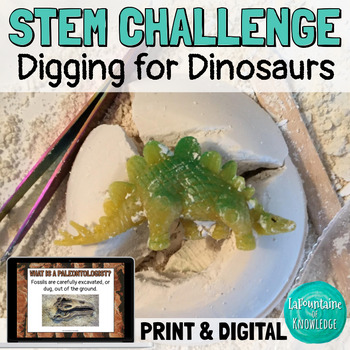Digging for Dinosaurs Paleontology Fossils Science Lab PRINT and DIGITAL
- PDF
Also included in
- This collection of easy to implement STEM challenges and hands on science lab experiments covers topics like: the moonsolar power light energysound energyanimal adaptations earthquakesvolcanoespaleontologygeometrysurface tensionEach resource in the bundle includes: background informationstudent direPrice $35.13Original Price $70.25Save $35.12
- This bundle includes 10 hands-on science labs and activities all related to the Earth: rocks, fossils, minerals, crystals, tectonic plates, earthquakes, volcanoes, paleontology, etc. This bundle includes: Experiment: Modeling the Rock Cycle with StarburstExperiment: Modeling Tectonic Plates with GraPrice $22.20Original Price $37.00Save $14.80
Description
In this STEM challenge, students must excavate a dinosaur "fossil" out of Plaster of Paris using various tools. Through this simulation, students will experience first hand some of the challenges paleontologists face in the field. This hands on experiment is the perfect addition to a unit on fossils and paleontology.
This resource includes:
- teacher directions, discussion questions and extension activities
- background information about paleontologists and fossil excavations
- student directions with photos to introduce the challenge
- a student response worksheet
- a scoring rubric
- a force copy link to a digital Google Slides version
Get my growing STEM bundle instead and save 50%! The best news is you'll get all future STEM resources that I add for free!
Please follow my store here for more great resources!
You can also find me on Facebook, Instagram, and lafountaineofknowledge.com where you'll discover ideas, inspiration, and plenty of freebies! Or join my email list to get a monthly newsletter with exclusive FREE resources you can't get anywhere else!
Want free money to spend on Teachers Pay Teachers? Rate this product to earn some TpT credit! Leaving feedback helps us both out and takes less than a minute! Your support makes it possible for me to continue making and sharing great resources! Thank you!







